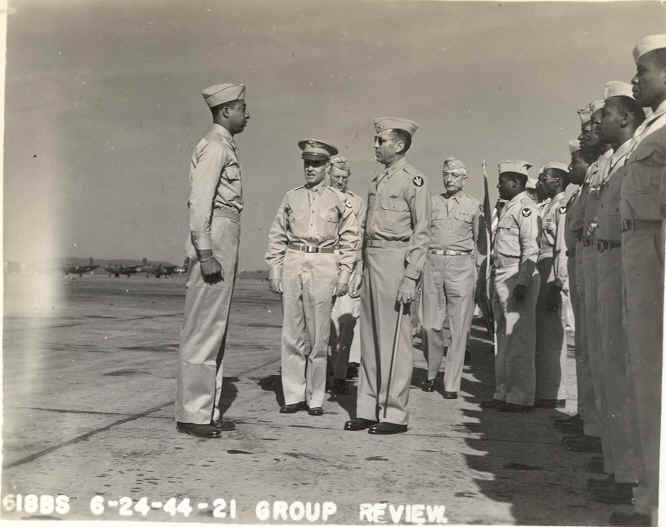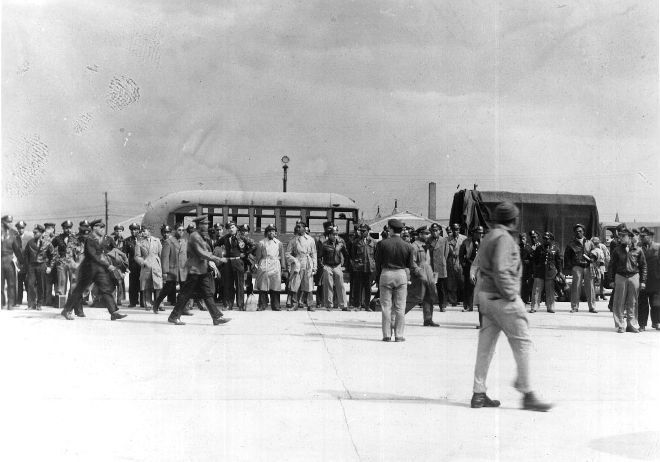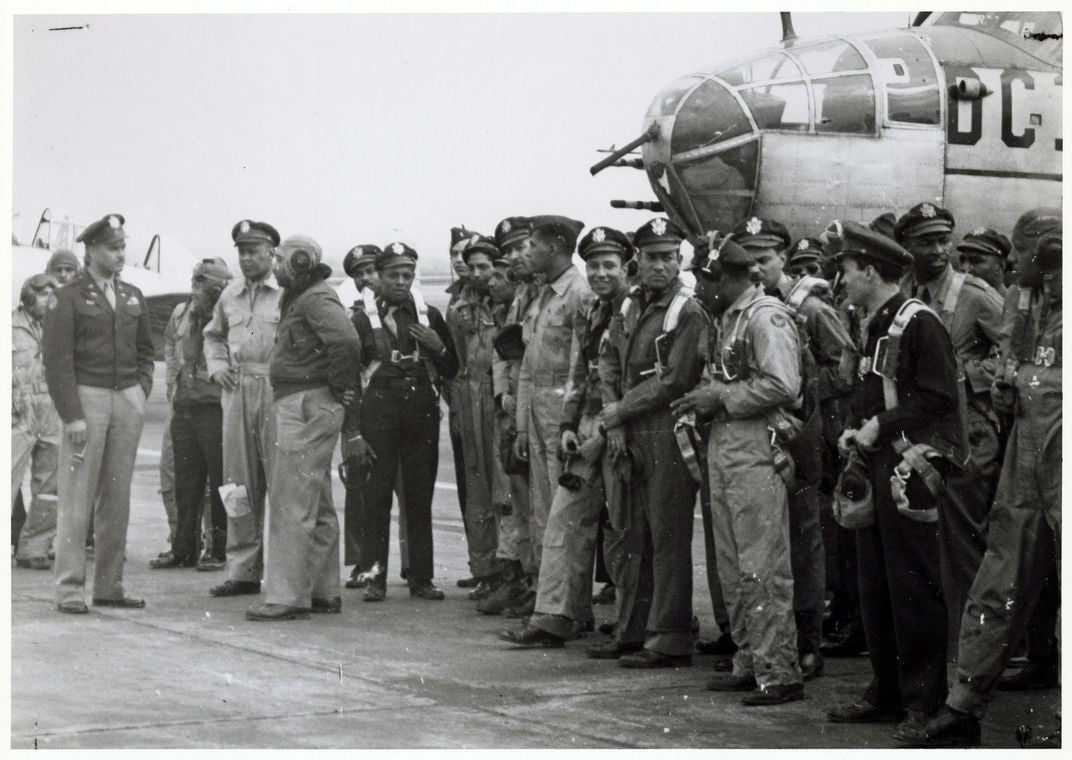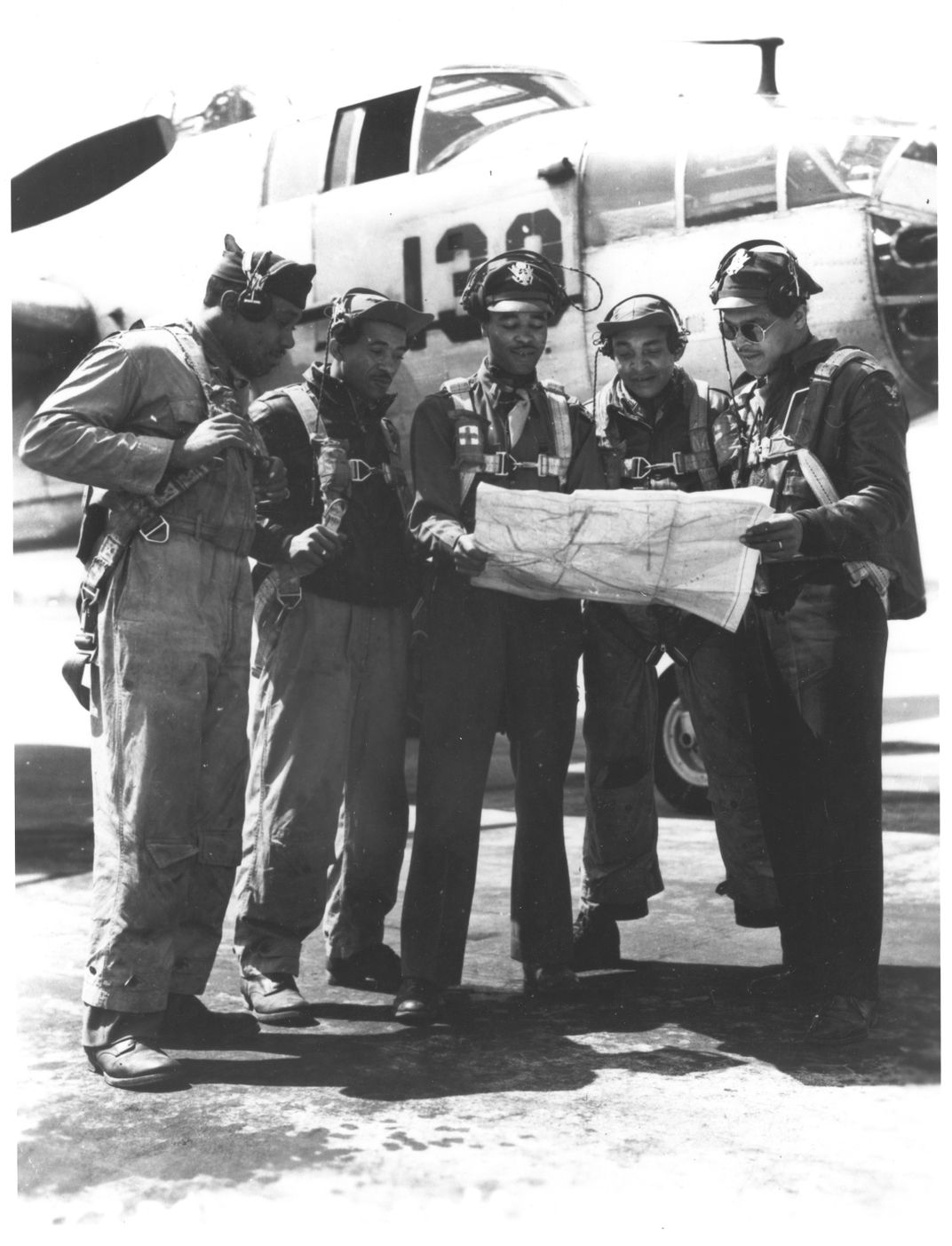Mutiny at Freeman Field: The Tuskegee Airmen on Trial, Part 2
In 1945, the Tuskegee Airmen of the 477th Bombardment Group protested discrimination at Freeman Field through pre-planned displays of resistance against the segregated officers’ clubs.
:focal(330x231:331x232)/https://tf-cmsv2-smithsonianmag-media.s3.amazonaws.com/blogging/featured/Freeman_Field_Mutiny.jpg)
The Tuskegee Airmen have become popular symbols of increasing diversity and representation in the U.S. armed forces, but the extent to which they had to fight to establish themselves, risking their careers and lives not only against enemy fire but against their own leaders, is not as well known. No group made that more clear than the 477th Bombardment Group. Although they never saw combat, they fought for freedom as hard as anyone of their generation through their actions of collective resistance at Freeman Field, Indiana.
Segregation On and Off Base
The 477th had already endured a long history of racial discrimination, inadequate training, and major blows to morale caused by their own leaders (as documented in the previous entry in this series). The group’s arrival at Freeman Field was marked with tension. The local town’s businesses refused to serve African American officers, while white officers on the post bristled at suddenly being in the minority. Commander of the First Air Force Maj. Gen. Frank Hunter, who himself had been responsible for many of the discriminatory policies against the 477th, sent an intelligence agent to get a sense of the situation. The report included several statements taken from white AAF officers who expressed their contempt for having to serve alongside African Americans. Some complained about the smell of African Americans and were offended at the thought of equality. Others displayed an eagerness for violence against their fellow officers, as one said: “If one of them makes a crack at my wife, laughs or whistles at her, like I saw them do to some white girls downtown, so help me, I’ll kill him.” Another bragged about taking part in lynching, saying “I killed two of them in my hometown, and it wouldn’t bother me to do it again.”

The group’s commander, Col. Robert Selway, upon arrival at Freeman in March 1945, ordered the creation of two separate officers’ clubs. Segregating the clubs by race would have been a direct violation of AAF regulations that demanded officers’ facilities be open to all officers. Selway indicated that one of the clubs was designated for “trainees,” and the other for “instructors.” It just so happened that all the trainees were African American and all the instructors were white, despite the fact that many of the African American “trainees” already had logged significant combat hours and outranked some of the white officers. Furthermore, transcripts of telephone calls with Selway and Hunter revealed that the trainee/instructor scheme was merely a cover for race, as both of them repeatedly referred to the instructor club as the “white” club, making sure that the official orders “don’t say anything about color, race, or creed.” Hunter hoped that the growing resentment would give him a pretext for further action, telling Selway “I’d be delighted for them [the African American officers] to commit enough actions that way so I can court-martial some of them.”
Civil Disobedience
On April 5, 1945, the African American officers began a pre-planned display of resistance. In small groups of just a few officers at a time, they began entering the white “instructor” club, 36 of them getting arrested in the process. The next night the same tactic played out again, with another 25 arrested. The club was then closed, and 110 officers wrote to the Army Inspector General to request an investigation into the arrests. The complaint specifically noted the inherent hypocrisy of U.S. racial policies in the context of the struggles of World War II, stating: “The continuance of this policy can hardly be reconciled with the world wide struggle for freedom for which we are asked, and are willing, to lay down our lives.”
Selway and Hunter, under the advice of the Judge Advocate, released all the arrested officers except three, who they claimed had used physical force to push their way into the club. Selway then drafted a new regulation outlining his policy of assigning trainees and instructors to different facilities and assigning those designations by race—against the objection of the First Air Force Inspector General, who noted that approximately 20 of the African American officers were not trainees in any sense. Selway, working with Hunter, then ordered all of the officers to read the new regulation and sign a statement certifying that they understood it, under penalty of the 64th Article of War, which directed that refusal to obey a direct order would result in punishment up to death. Of the 422 African American officers assigned to the 477th, 101 of them refused to sign and were arrested.

Many of these officers drafted and signed separate statements outlining their reasons for refusing to sign the racially discriminatory order, most of which are stark and powerful. One officer wrote that obedience “would have done violence to the conscience of the undersigned; it would have constituted moral conduct less than that required of an officer and a gentleman in the Army of the United States.” Another stated: “The undersigned wishes to indicate over his signature his unshakable belief that racial bias is Fascistic, un-American, and directly contrary to the ideals for which he is willing to fight and die.”
Under Pressure
The 101 officers who refused to sign were sent back to Godman Field, Kentucky, and the rest of the 477th followed shortly thereafter. This was a brazen attempt to eliminate the program of African American pilots altogether. In a phone conversation to the First Air Force’s chief of training, General William Welsh, the chief of staff of the Air Force for training said of the move: “If we can stave it off in some way for a period of time… maybe we can eliminate the program gradually and accomplish our end.” But the officers of the 477th had planned carefully. Not only did they write formal complaints through official channels to their command structures, but they had communicated with organizations like the NAACP and tipped off a local reporter so that the incidents were documented in the public press. This, combined with Selway and Hunter’s transparent actions, drew the attention of the highest authorities in the nation.
President Harry Truman was informed of the occurrences at Freeman and Godman fields. Shortly after, the Chief of Staff of the U.S. Army, Gen. George Marshall, ordered that the 101 arrested officers be released at once. Hunter complied but insisted that a letter of reprimand be added to their permanent records. Under pressure from the War Department, AAF commander Gen. Henry “Hap” Arnold replaced Selway with Col. Benjamin O. Davis Jr., who took command of the 477th and of Godman Field. Displaying the pettiness typical of institutional racism, Hunter refused to attend the change of command ceremony.

Courts-Martial
Nevertheless, after significant debate, the AAF Chief of Justice Col. R.E. Kunkel, who argued for the release of all the arrested officers, compromised with Hunter, who wanted them all tried, settling on courts martial for the three officers accused of a physical altercation with the white officer blocking the door when they had entered the club. Lt. Marsden Thompson and Lt. Shirley Clinton were tried together while Lt. Roger Terry was tried separately. The NAACP sent a legal team led by Ted Barry, president of the organization’s Cincinnati branch. The board judging over the trial consisted of six African American officers, whom every single white officer called to testify refused to salute. In each case the proceedings came to a halt so each white officer could be reminded that a salute was the military custom.
The testimonies revealed inconsistencies in how admittance to the club was allowed. It became quickly obvious that skin color was the determining factor. Selway’s testimony was the most dramatic, as he objected to every question, arguing that they were “irrelevant and immaterial.” After being repeatedly reminded that witnesses do not have the right to object to questions, Selway was labelled a hostile witness. His testimony also contradicted what had been recorded in his own telephone transcripts. In the final verdict, Thompson and Clinton were both acquitted. Terry was found not guilty of disobeying an order, but guilty of “jostling a superior officer.” The prosecution had asked for the death penalty. Instead, Terry was fined $150. The fee was paid via a collection from his fellow officers.

Legacy
The Freeman Field Mutiny, as it became known, led to drastic change for the time. Davis was able to remove the promotional log jams in the 477th, allowing African Americans into the command positions they had earned. The AAF convinced the War Department to pass a new regulation prohibiting racial segregation in base facilities, as well as conduct a thorough review of discriminatory policies throughout the military. Despite this progress, racial bias in the air arm was far from eliminated and Davis encountered heavy resistance. For example, the post commander at Fort Knox near Godman Field complained to the First Air Force headquarters, saying: “We have four General Officers living here… by God, they just don’t want a bunch of coons moving in next door to them.” The 477th never saw combat, largely because the war soon came to an end, but also because Gen. George Kenney, air force commander in the Pacific, worked to prevent the 477th from being sent to the theater, against the recommendations of Gen. Douglas MacArthur and Lt. Gen. Ira Eaker.
In spite of this, the AAF, soon to become the independent U.S. Air Force, gradually became more racially inclusive. The Air Force ordered an end to its segregation policies before President Truman issued his executive order that officially integrated all the armed services. Although full racial integration of the armed services took three more years of hard work, the fallout from the Mutiny at Freeman Field set the services firmly on that path. Exactly 50 years after the mutiny, in 1995, the US Air Force exonerated those who had been arrested, finally removing Hunter’s reprimand letters from their records and expunging Terry’s conviction.
Although many of the Tuskegee Airmen made remarkable combat achievements, their greatest victories were against systemic racial injustice, forcing the nation to hold closer to the ideals of liberty and equality enshrined in its founding documents. Seventy-five years later, that fight is far from over. The tactics used by the 477th of peaceful civil disobedience combined with forging connections to activist organizations and press outlets to put political pressure on national leaders all served to further their cause. Those efforts serve as a powerful example of how meaningful change can still be achieved. As Col. Benjamin Davis Jr. said: “The privileges of being an American belong to those brave enough to fight for them.”
